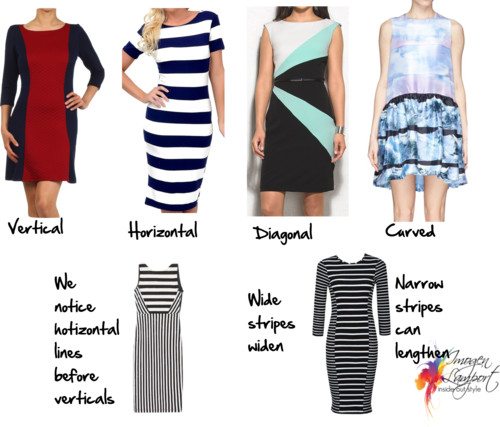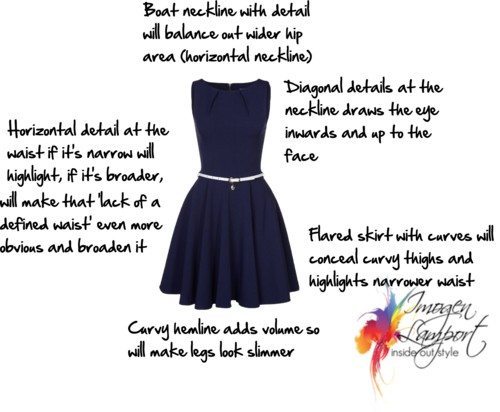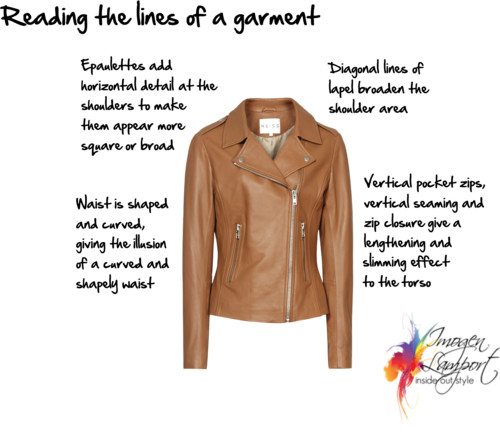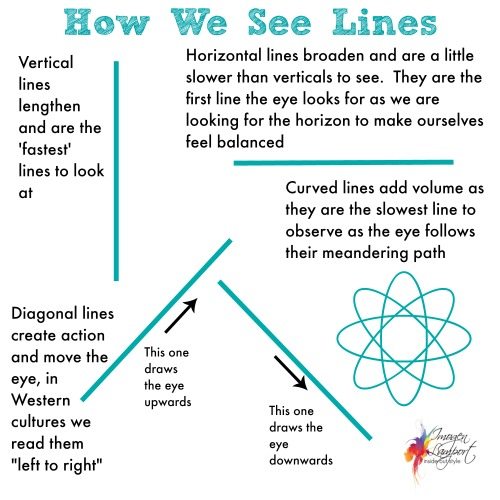
Given the number of people who contact me asking about identifying their body shape (if you’re not sure what body shape you have, do the Body Shape Quiz to find out!), it’s obviously something that is considered to be an important factor in the whole “finding flattering clothing” issue that many women face. I’m here to tell you that yes, it is important, but no, it’s not everything (in fact I wrote a post about how personality is 10 times more important than body shape when choosing outfits and garments).
So today I’m going to share with you what knowing your body shape will tell you and how you can use some of my magicians toolbox of rules, to use these illusions to flatter your figure.
Body shape is your outline, from the front (pretty much) it’s your silhouette. We determine your shape based on the differences between shoulders (not bust), waist and hips/upper thigh.
It does not take into consideration your upper arms, your knees or calves, or your body proportions, whether you are petite or tall, the roundness or flatness of your bottom or all the other body variations.
But what does your body shape quiz doesn’t tell you? Watch my video here.
When you are thinking about how to flatter your body shape (which you can find out about ‘diagnosing your body shape’ here, or if you’re still stuck and want more personal attention and my input, it’s part of my 7 Steps to Style program), you need to understand the rules of line and how we interpret and see lines.
Vertical lines
Vertical lines lengthen and can slim the body. They create the illusion of height or length. The eye moves quickly over them.
Horizontal lines
Horizontal lines broaden or widen. The eye moves more slowly over them and we are constantly looking for horizontals as we search for the horizon as it gives us a feeling of balance. Every hem (unless it’s asymmetric) is a horizontal line.
Diagonal lines
Diagonal lines move the eye and create action. The more ‘vertical’ the diagonal the more it works to slim, the more ‘horizontal’ the diagonal it becomes more broadening. In Western cultures where we read left to right, we also look at horizontals from left to right, so some take our eye upwards, others downwards.
Curved lines
Curved lines add volume (or as my American image consultant friends say “round adds pounds”). They are the slowest lines for our eyes to follow as we have to move over more area to follow them (this is why they add that volume).

Understanding a little about lines helps us think about how to dress our body shape, how to alter it using our ‘magician’s toolbox of illusion’. Want to look taller? Add in some more verticals. Want to balance your hips? Add a horizontal line element across your shoulders. Want to move the eye upwards, consider wearing a jacket which draws the eye upwards (vertically with it’s opening) and then outwards (with it’s diagonal based lapel). Want to add curves? Put a frill over that area.
What Does Knowing Your Body Shape Really Tell You?
It gives you an indication of how to use lines to balance and flatter. And it tells you where to put detail or draw focus with design elements or accessories, plus where to keep plain and boring (no details) so you don’t draw attention to that area if you don’t want people to notice it (camouflage).
So when you think about flattering your body shape. Think about:
- Where to put the horizontal lines to broaden or balance or highlight (if it’s a narrow horizontal)
- Where to put the vertical lines to lengthen and/or slim
- Where you can use diagonals to move the eye
- Where you can use curved lines to follow the body or add volume (a straight line over a curved body part often looks pulled/bent and doesn’t flatter)
You can take my Body Shape Calculator quiz here to get an idea of your body shape.
How to Read a Garment’s Lines

So you can see, analysing the lines on a garment will give you and understanding of how that garment will make you look. Before you try anything on, look at the lines and how it’s constructed even seams and darts can add lines into a garment and will influence how it appears on the body. This dress above would look fabulous on an A shape as it shows off the slim waist, hides the hips/thighs and balances the wider hips with a shoulder broadening horizontal at the neckline.
Here is another example.

This garment:
- Broadens shoulders
- Shapes waist
- Lengthens torso
So it would be ideal for an H shape who doesn’t have really square shoulders.
What Body Shape Doesn’t Tell You
- What you like
- How long hems should be
- Shapes of accessories and details
- Shoe shapes and styles
- Scale of elements and patterns
- Everything I listed in this blog post
Can you see how when you understand how lines work, you can figure out what kinds of garments and design elements you are looking for to flatter your figure?

















Thank you! This was very informative and helpful!
wow, excellent explanation! THank you, Imogen.
good post, often the pear shape apple etc recommendations dont look at the individuals positives and a lot of the advice doesnt run true for all, so in so far as there is no such thing as a one size fits all – no style rule is absolute………………
Every body is unique and many generic recommendations are only that, you still, within that need to figure out which parts work for you and which to ignore.
What is the oval body shape? I haven’t seen this one in your posts. Thanks
Oval is an O shape https://insideoutstyleblog.com/?s=o+shape
I love all the knowledge you share here Imogen. The description of lines is amazing. Really helpful for women looking to accentuate the positives! I do agree that personality trumps body shape though.
Bron x
Yes Understanding the principles of line is so important and we teach this and so much more in our personal stylist training as it tells you what suits each shape and how to create illusions. It amazes me that it is not taught more widely in fashion which is why there is so much bad design in the clothing marketplace.
Hi Imogen, I loved the article, it really is true that body shape is more than just waistline, tall or short height.
I for example, am something of a slim 8 to H shape, so finding summer tops should be easy. It’s not. I love shopping, but I dread shopping for summer tops, since my upper arms are very full, which makes me look more like a V shape in most tops. The combination of crew necks or V-necks on most tops with short sleeves (which always end at the wrong point) or no sleeves at all makes me look like a linebacker. Neckholders and tube tops are even worse. I am quite flat-busted, so deep necklines look disappointing on me. It’s so complicated! I can’t be the only one with this problem?
Maybe you could do a special just on T-shirts or tank tops? These are the most basic items of clothing but, I feel, they are also the most ifficult to choose.
Yes it’s tricky when we have body variations that take us out of the manufacturing standard – you may find that woven tops rather than knits work better for you.
Wow, Imogen, you are a genius I have to admit!